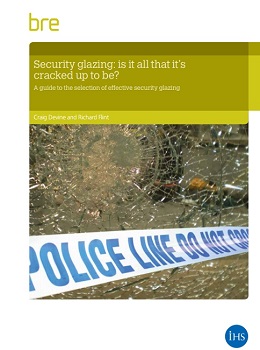Security glazing
In October 2016, BRE published the findings of a research project undertaken to investigate the performance and safety of glazing in security applications. The guide was primarily developed to help with the selection of effective security glazing.
The publication of ‘Security glazing: Is it all that it’s cracked up to be?’ (FB 55) followed a series of burglaries in London’s West End in 2008, ‘smash-and-grab’ attacks used to steal expensive goods from shop window displays.
The research explored the notion that, in some cases, glazing offered the least resistance to forced entry in situations where the generation of noise did not deter criminals. This premise was further demonstrated in the 2011 riots that hit major cities around the UK.
In addition to focusing on security, the research also examined an associated safety issue – that the majority of injuries from explosive events, including terrorist attack, invariably result from flying glass particles. Therefore, finding the correct specification of glazing to resist attack and reduce injury is vital.
The research uncovered a problem relating to the selection of an appropriate product to meet these dual requirements. A number of different glazing standards have been developed based upon specific test requirements. For example, glazing may be subject to a simulated manual attack or impacted by a known mass at a known velocity. However, the test results are not always directly comparable with those of tests conducted to other standards.
It is therefore useful to have an understanding of which standard is best suited to a particular application.
The types of glazing that the guide covers include:
- Acrylic.
- Fire-resistant glass.
- Float glass.
- Glass brick.
- Insulated glazing units.
- Laminated glass.
- Polycarbonate.
- Toughened glass.
- Wired glass.
The guide aims to assist architects, consultants, police officers and others who advise people on the selection of effective security. As well as focusing on physical security, particularly the resistance to manual attack of different glazing types, the guide also contains advice relating to other performance attributes.
You can download the guide from BRE Bookshop.
[edit] Related articles on Designing Buildings Wiki
- Annealing.
- BRE articles on Designing Buildings Wiki.
- Building fabric.
- CCTV.
- Electric lock.
- Embedded security: Procuring an effective facility protective security system.
- Fire detection and alarm systems.
- Glass.
- Glass block wall.
- Glass manifestation.
- Glazing.
- How to install an underfloor safe.
- Outbuildings security.
- Patent glazing.
- Perimeter security.
- Polycarbonate plastic.
- SABRE Security Assurance by the Building Research Establishment.
- Safety glass.
- Secondary glazing.
- Security and the built environment.
- Types and manufacture of laminated glass.
- Types of alarm.
- Types of lock.
Featured articles and news
The UK's Modern Industrial Strategy: A 10 year plan
Previous consultation criticism, current key elements and general support with some persisting reservations.
Building Safety Regulator reforms
New roles, new staff and a new fast track service pave the way for a single construction regulator.
Architectural Technologist CPDs and Communications
CIAT CPD… and how you can do it!
Cooling centres and cool spaces
Managing extreme heat in cities by directing the public to places for heat stress relief and water sources.
Winter gardens: A brief history and warm variations
Extending the season with glass in different forms and terms.
Restoring Great Yarmouth's Winter Gardens
Transforming one of the least sustainable constructions imaginable.
Construction Skills Mission Board launch sector drive
Newly formed government and industry collaboration set strategy for recruiting an additional 100,000 construction workers a year.
New Architects Code comes into effect in September 2025
ARB Architects Code of Conduct and Practice available with ongoing consultation regarding guidance.
Welsh Skills Body (Medr) launches ambitious plan
The new skills body brings together funding and regulation of tertiary education and research for the devolved nation.
Paul Gandy FCIOB announced as next CIOB President
Former Tilbury Douglas CEO takes helm.
UK Infrastructure: A 10 Year Strategy. In brief with reactions
With the National Infrastructure and Service Transformation Authority (NISTA).
Ebenezer Howard: inventor of the garden city. Book review.
The Grenfell Tower fire, eight years on
A time to pause and reflect as Dubai tower block fire reported just before anniversary.
Airtightness Topic Guide BSRIA TG 27/2025
Explaining the basics of airtightness, what it is, why it's important, when it's required and how it's carried out.
Construction contract awards hit lowest point of 2025
Plummeting for second consecutive month, intensifying concerns for housing and infrastructure goals.
Understanding Mental Health in the Built Environment 2025
Examining the state of mental health in construction, shedding light on levels of stress, anxiety and depression.
The benefits of engaging with insulation manufacturers
When considering ground floor constructions.
Lighting Industry endorses Blueprint for Electrification
The Lighting Industry Association fully supports the ECA Blueprint as a timely, urgent call to action.

























